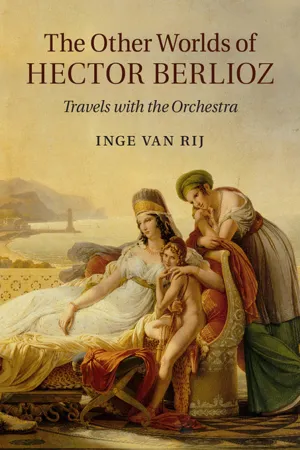
- English
- PDF
- Available on iOS & Android
About this book
Berlioz frequently explored other worlds in his writings, from the imagined exotic enchantments of New Zealand to the rings of Saturn where Beethoven's spirit was said to reside. The settings for his musical works are more conservative, and his adventurousness has instead been located in his mastery of the orchestra, as both orchestrator and conductor. Inge van Rij's book takes a new approach to Berlioz's treatment of the orchestra by exploring the relationship between these two forms of control – the orchestra as abstract sound, and the orchestra as collective labour and instrumental technology. Van Rij reveals that the negotiation between worlds characteristic of Berlioz's writings also plays out in his music: orchestral technology may be concealed or ostentatiously displayed; musical instruments might be industrialised or exoticised; and the orchestral musicians themselves move between being a society of distinctive individuals and being a machine played by Berlioz himself.
Frequently asked questions
- Essential is ideal for learners and professionals who enjoy exploring a wide range of subjects. Access the Essential Library with 800,000+ trusted titles and best-sellers across business, personal growth, and the humanities. Includes unlimited reading time and Standard Read Aloud voice.
- Complete: Perfect for advanced learners and researchers needing full, unrestricted access. Unlock 1.4M+ books across hundreds of subjects, including academic and specialized titles. The Complete Plan also includes advanced features like Premium Read Aloud and Research Assistant.
Please note we cannot support devices running on iOS 13 and Android 7 or earlier. Learn more about using the app.
Information
Table of contents
- Cover
- Half title
- Title
- Copyright
- Dedication
- Contents
- List of figures
- List of music examples
- Acknowledgements
- Introduction
- 1 Travels with the orchestra: Travel writing and Berlioz’s
- 2 Conquering Other worlds: Military metaphors, virtuosity, and subjectivity in Symphonie funèbre et triomphale and Harold en Italie
- 3 Visions of Other worlds: Sensing the supernatural in Épisode de la vie d’un artiste and La nonne sanglante
- 4 Back to (the music of) the future: Aesthetics of technology in Berlioz’s Euphonia and Damnation de Faust
- 5 Exhibiting Other worlds: Les Troyens, museum culture, and human zoos
- Epilogue
- Select bibliography
- Index